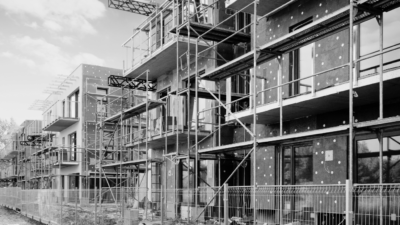The UK’s residential construction industry could increase in value by almost 20% by 2025, despite the fact that its current performance is yet to fully return to pre-pandemic strength.
Today, there are some 44,166 businesses operating across the UK’s residential construction industry, generating total revenue to the tune of £78.9 billion, with each business contributing an estimated average revenue of £1.8 million.
As it stands, current market performance remains down when compared to pre-pandemic levels.
The number of businesses is down -7.1% while total market value is down -11.0%, resulting in the average revenue per business also falling by -4.3%.
However, the annual figures suggest that while the residential construction industry is yet to fully return to pre-pandemic health, it’s certainly heading in the right direction.
While the number of total businesses is still some -6.0% fewer than 2021, total market value and the resulting average revenue per business are both up 18.9% and 26.5% respectively.
Not only are these promising signs for the sector as it stands, but this growth is forecast to continue over the coming years.
New market analysis by Unlatch estimates that the number of active industry businesses within the resi construction industry could increase by 30% by 2025, reaching a total of 57,401.
This increase is also expected to drive total market value to £93.6 billion – an increase of 18.7%.
The only downside to this sector expansion being that with more businesses operating within it, the average revenue per business is expected to decline by -8.7%.
Lee Martin, Head of UK for Unlatch says:
“Like many sectors of the property market, the residential construction industry certainly faced a number of challenges as a result of the pandemic.
While we’re yet to see a full return to form, there are some very positive signs of growth on an annual basis, with the pandemic market boom helping to drive revenue growth.
This growth is expected to continue through to 2025 and we predict that the biggest worry facing many in the sector will be an increased level of competition, rather than a dent to their profit margins.
It’s those who continue to innovate and progress the way we deliver residential property to market that are likely to come out on top, not just with respect to the construction process, but also when streamlining the sales process, benefitting both builder and homebuyer alike.”
| Table shows the estimated size and value of the UK’s residential construction industry from 2012 to 2022, plus forecasted growth up to 2025 | |||
| Year | Est number of businesses | Est market size £ (measured by revenue) | Est average revenue per business |
| 2012 | 26,803 | £48,573,700,000 | £1,812,249 |
| 2013 | 27,695 | £51,811,800,000 | £1,870,800 |
| 2014 | 28,982 | £51,135,600,000 | £1,764,392 |
| 2015 | 31,631 | £59,163,400,000 | £1,870,425 |
| 2016 | 37,185 | £68,013,700,000 | £1,829,063 |
| 2017 | 41,897 | £70,279,600,000 | £1,677,438 |
| 2018 | 44,796 | £77,163,200,000 | £1,722,547 |
| 2019 | 47,531 | £88,669,800,000 | £1,865,515 |
| 2020 | 47,441 | £84,130,800,000 | £1,773,377 |
| 2021 | 47,001 | £66,340,100,000 | £1,411,461 |
| 2022 | 44,166 | £78,872,700,000 | £1,785,824 |
| Forecast – 2023 | 52,693 | £86,762,695,324 | £1,646,555 |
| Forecast – 2024 | 55,047 | £90,189,484,788 | £1,638,397 |
| Forecast – 2025 | 57,401 | £93,616,274,251 | £1,630,908 |
| 1 year change (2021 vs 2022) | -6.0% | 18.9% | 26.5% |
| Pandemic change (2019 vs 2022) | -7.1% | -11.0% | -4.3% |
| Forecast change (2022 vs 2025) | 30.0% | 18.7% | -8.7% |
Number of active businesses data sourced from IBISWorld
Overall residential construction market size data sourced from IBISWorld

























Comments